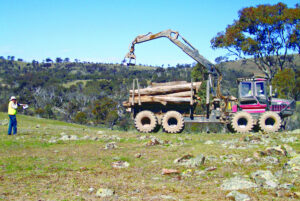While the outlook for those interested in biodiversity conservation in Australia is often grim, our book Biodiversity and environmental change: monitoring, challenges and direction does contain some good news and success stories. Several examples are to be found in eucalypt woodlands, one of our country’s most productive landscapes.
A long-term experiment in a woodland reserve on the north-eastern boundary of the Australian Capital Territory (ACT) may be some time in delivering results of an ecological kind, but it has already borne fruit in other respects. The Mulligan’s Flat–Goorooyarroo Woodland Experiment is a successful collaboration between statisticians and ecologists, and between the ACT Government and scientists from CSIRO and the Australian National University.
The reserve protects an area of grassy woodland with yellow box and Blakely’s red gum which, like most temperate eucalypt woodlands, is endangered.
In the experiment, the ecologists and statisticians are using their combined skills and mingling research and habitat restoration to look for the best ways to save this woodland type – and all with the support of the ACT government.
They are applying different treatments to segments of the park to work out the best ways to restore the structure and function of the woodland to increase biodiversity. They are:
- adding dead wood for habitat and to increase the structural complexity of the ecosystem;
- excluding kangaroos to give regrowth a chance to establish;
- re-introducing traditional Aboriginal fire-management patterns, to replicate age-old pre-European disturbance; and
- re-introducing the eastern bettong (an inveterate digger for tasty underground fungi, roots and tubers) to understand how it affects regeneration, and how regeneration affects it.

 Workers add dead wood for habitat and to increase the structural complexity of the ecosystem at Mulligan’s Flat–Goorooyarroo Woodlands in the ACT (photo courtesy of Adrian Manning)
Workers add dead wood for habitat and to increase the structural complexity of the ecosystem at Mulligan’s Flat–Goorooyarroo Woodlands in the ACT (photo courtesy of Adrian Manning)Once the ecological results are in, they will be translated into park management policy. The team expects the results will also inform other restoration projects, particularly in temperate eucalypt woodlands.
Not far away, ecologists have detected that, contrary to popular perception and scientific understanding, some species of woodland birds are increasing, despite heavy clearing of their habitat over many decades in southern New South Wales.
They’ve been able to detect this only through long-term monitoring, said Professor David Lindenmayer, who is the Science Director of the Long Term Ecological Research Network (LTERN) and the research lead for three of LTERNs plot networks. Reporting both at the 2013 TERN symposium and in our book, he said that the difference in research findings was due to the fact that the previous short-term studies were snapshots of the time they were conducted and could not show the trends in population changes needed to demonstrate decline or increase, so what was happening with some species was invisible to researchers.
Because of long-term monitoring in these eucalypt landscapes, we now also know that:
- re-planted woodlands and natural regrowth are both important habitats for birds and reptiles, including some that are ‘of concern’ to conservation; and
- planted areas can complement old-growth woodland.
Important findings, such as these, demonstrate the value of long-term ecological research in Australia for monitoring environmental change and biodiversity. Long-term studies are necessary to understand ecosystem processes, identify the drivers of change and provide the evidence and knowledge needed to inform better natural resource management in Australia.
Published in TERN newsletter February 2014






